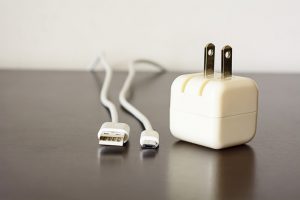
All of our electronic devices, including smartphones, tablets, fitness trackers, and more, provide us with many individual chargers. A single cable can allow you freedom from having individual chargers for each device.
We typically have multiple devices to charge on a regular basis.
If you use individual chargers that accompany each device, then you will quickly use many outlets in order to charge your phone, tablet, and any other device. An option is that you could obtain a power strip and plug all the individual chargers into that strip. However, that is an inefficient solution, since each charger runs on an individual AC to DC transformer. A simpler solution that reduces clutter and is more energy efficient is to utilize a multi-port USB charging station. This device allows you to use a single power outlet for one transformer and provides power to four or more USB ports. Different types of USB charging stations are available, so you will want to be sure to research features offered when considering a purchase.
Choosing the Correct USB Charging Station
Since there are numerous models available in a wide range of prices, finding the right charging station can become complicated. To help you determine which would best suit your needs, consider the options outlined below.
-
UL certification. Safety certification by the Underwriters Laboratory (UL) is an important designation. Since there have been a number of extremely low quality and uncertified chargers available for sale, they are not only less energy efficient, but can also possibly damage your devices and even create a fire hazard. Considering that many people use their chargers in their bedrooms, safety is of vital importance.
-
Number of ports. You certainly need to make sure you have an adequate number of ports to charge all your electronic devices. If you currently have two devices, for example, then do not limit yourself to a charging station with only two ports. The difference in price between models is minor when the device is priced on the basis of the number of ports.
Be sure to allow yourself room to expand by purchasing a charger with more ports than you currently need. This will help you to maintain your goal of reducing clutter by using only one outlet when you expand your inventory of electronic devices that require charging.
-
USB cables. Using a substandard USB cable can hinder full-power charging of your devices. Even though the cables that accompany smartphones are sufficient, some of the generic micro USB cables do not perform the job very well. If you have ever discovered that your electronic device loses its charge over a short time, then you are most likely using a charger that provides insufficient power to that device.
-
Various port amperages. USB ports on charging stations have various amperage yields, which can make a big difference in how quickly your devices will charge.
Basic USB amperage outputs are 1A, 2.1A, and 2.4A. All USB devices will charge on lower amperage ports, but devices with large batteries require a longer amount of time to recharge completely on lower amperages. For larger batteries, you will want to have some higher amperage ports for recharging. If you find yourself comparing one or more chargers with equal features and similarities in price, then it is always a good decision to select the charger with more 2.1A or 2.4A ports. Even though chargers can have the same connector, different chargers can charge at various speeds. Larger, more powerful devices will demand chargers that function at a higher amount of milliamps. If you purchase a new charger, be sure to get one that provides a minimum amperage as your device requires.
Charging Station Forms
USB charging stations exist in the forms of wall chargers, corded chargers and organizers. The form you select usually depends on personal preference, as well as where you will be using the device. A wall charger is a single unit resembling a converter box that plugs directly into the wall, without the use of an extension cord. The box plug affixes onto the outlet and all the USB device cords get inserted directly into the box plug. A corded charger is basically the same as a wall charger, except it has a power cord tie to the outlet. This has the added benefit in that it provides more movement for you, as well as the plug can be used in smaller spaces than a wall-mounted charger. An organizer-style charging station is larger and has slots, racks, or caddies in which to place all your devices.
Specialty Features
The basic features outlined above are much more important than any specialty features that may accompany a charging station. However, there are instances where extra features do merit mentioning. Some chargers have ports with specialty circuits to use the benefits of various fast-charge technologies. Others may include wireless charging, along with their regular USB ports in order to let you set your wireless charging device straight on top. For a lot of users there is no advantage in selecting a charging station with device-specific features, but, if you have a device that supports the specific features, you may consider it beneficial to spend the extra money.
Conclusion
Having some knowledge regarding USB chargers and cables,
you should be able to find the perfect charger to fit your needs. You can also eliminate that power-strip containing numerous individual chargers cluttering up your kitchen counter or another area of your home by consolidating chargers.

 All of our electronic devices, including smartphones, tablets, fitness trackers, and more, provide us with many individual chargers. A single cable can allow you freedom from having individual chargers for each device. We typically have multiple devices to charge on a regular basis.
All of our electronic devices, including smartphones, tablets, fitness trackers, and more, provide us with many individual chargers. A single cable can allow you freedom from having individual chargers for each device. We typically have multiple devices to charge on a regular basis.


